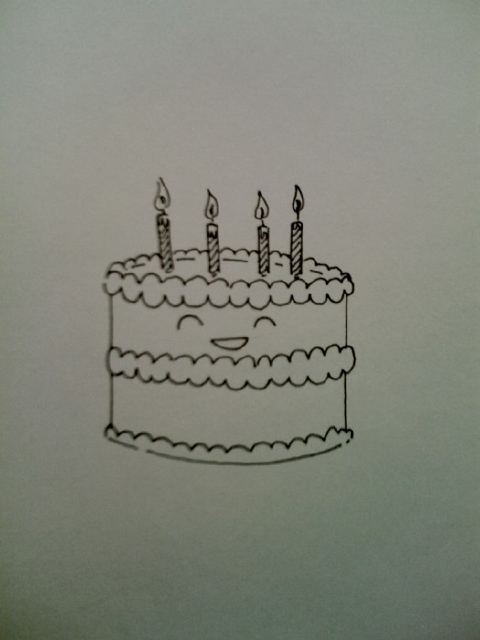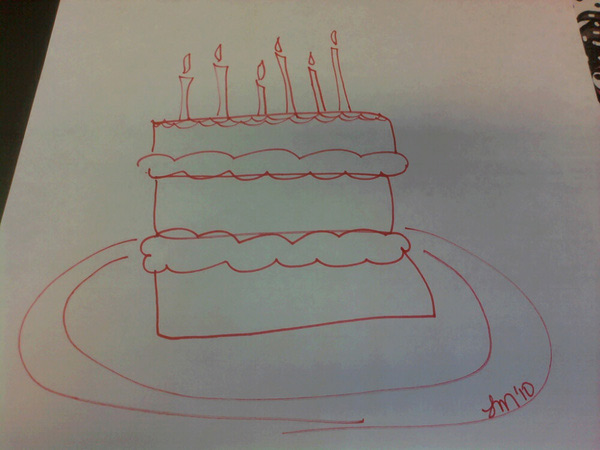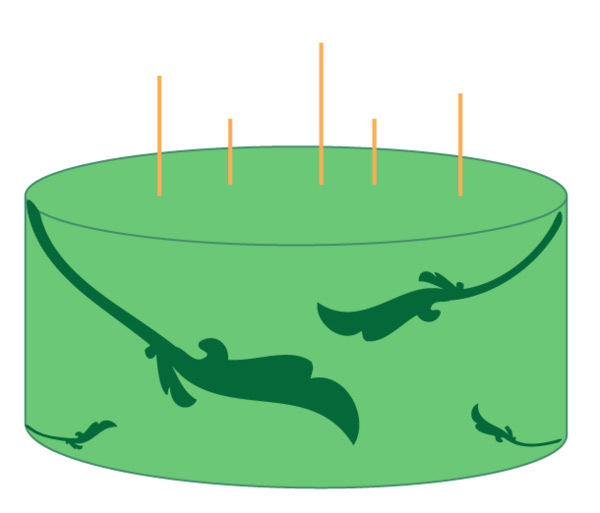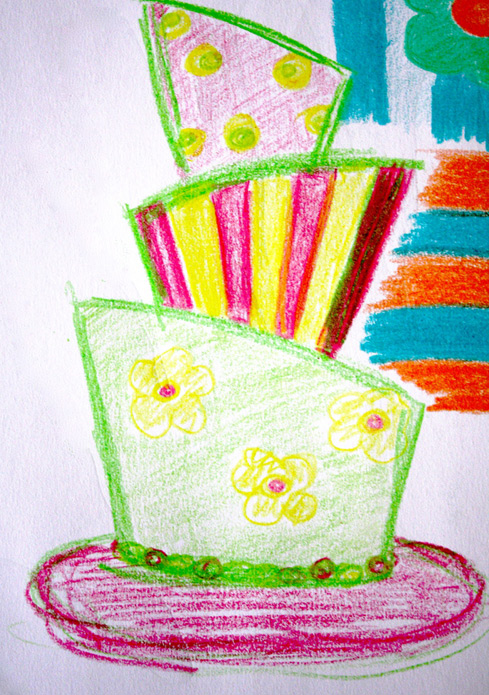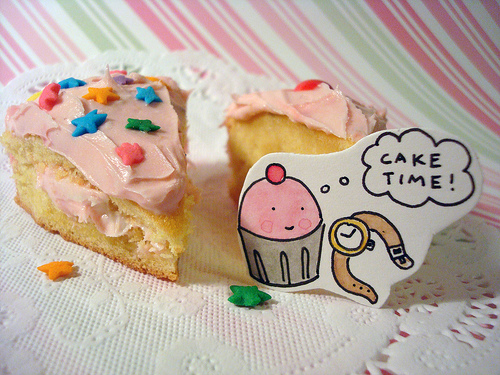 It's August 26th, and you know what that means: it's like, the biggest cake eating day of the year. That is to say...it's CakeSpy founder and Head Spy Jessie's (hi, that's me) birthday. But of course, while you're celebrating by eating slice after slice of sweet, buttercreamy, blissful birthday cake, one question might just come to your mind:
It's August 26th, and you know what that means: it's like, the biggest cake eating day of the year. That is to say...it's CakeSpy founder and Head Spy Jessie's (hi, that's me) birthday. But of course, while you're celebrating by eating slice after slice of sweet, buttercreamy, blissful birthday cake, one question might just come to your mind:
What is birthday cake, exactly?
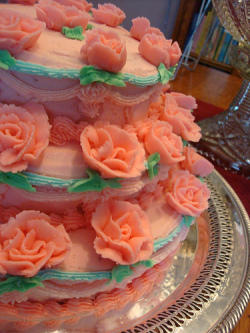 In my head, it's easy enough to conjure: it is a three tier white cake with pink buttercream frosting and roses and frosting piped in a scalloped pattern on the side. This is the birthday cake (pictured left) I got for many of my formative years growing up in New Jersey--yep, I was a lucky kid, all right.
In my head, it's easy enough to conjure: it is a three tier white cake with pink buttercream frosting and roses and frosting piped in a scalloped pattern on the side. This is the birthday cake (pictured left) I got for many of my formative years growing up in New Jersey--yep, I was a lucky kid, all right.
While people will likely have their own vision of the ideal birthday cake, the vision of what a birthday cake actually is seems universal: cake with lots of frosting, hopefully sprinkles or some sort of topping decoration, and candles.
To prove this point, I asked Twitter followers today (I know, I know) to submit a drawing of a birthday cake--just to see if people did have a classic vision of what a birthday cake looks like. Here were some of the submissions:
Don't know about you, but I feel like I noticed two definite themes: festivity and frosting. So regardless of whether you might prefer to eat a rich tiramisu or chocolate torte or even pie (who are you?) for your birthday, there is no denying that the birthday cake is an icon.
But why?
To understand, we're going to have to go way back in time, to ponder the roots of this sweet tradition.
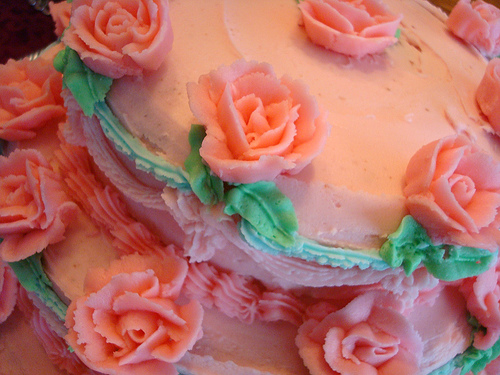 Where do Birthday Cakes come from?
Where do Birthday Cakes come from?
Per Food Timeline,
Cakes were eaten to celebrate birthdays long before they were called "birthday cakes." Food historians confirm ancient bakers made cakes (and specially shaped breads) to mark births, weddings, funerals, harvest celebrations, religious observances, and other significant events. Recipes varied according to era, culture, and cuisine. Cakes were usually saved for special occasions because they were made with finest, most expensive ingredients available to the cook. The wealthier one was, the more likely one might consume cake on a more frequent basis.
True to that point, as I discovered on What's Cooking America, there is evidence in several cultures of earlier versions of this celebration cake, ranging from honey cakes made in Ancient Greece to celebrate major occasions (the 50th birthday, for instance, was marked with a cake made from honey, flour, cheese, and olive oil) to cakes that date back to medieval times in England wherein hidden objects were said to give good luck to the finder (a tradition which still exists with the King Cake and Galette des rois) to a tradition dating back to medieval times in Germany wherein a sweetened bread dough was molded into the shape of Jesus in swaddling clothes to commemorate birthdays.
But what holds true in all of these cases is that serving cake for special occasions is something that dates way back--a tradition which has changed and evolved based on ingredient availability and flavor preferences.
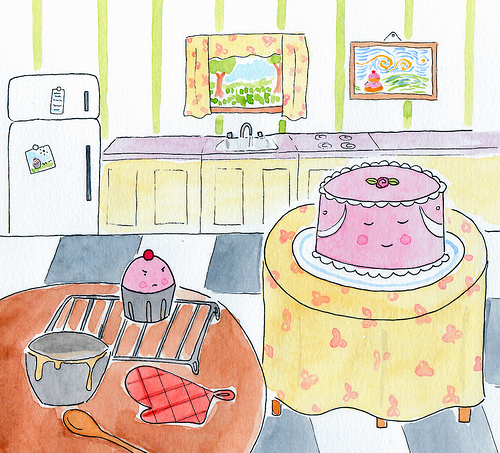 So how did we get to the fluffy, buttercream-frosted variety we commonly know in America today? As I discovered in The Oxford Encyclopedia of Food and Drink in America: 2-Volume Set
So how did we get to the fluffy, buttercream-frosted variety we commonly know in America today? As I discovered in The Oxford Encyclopedia of Food and Drink in America: 2-Volume Set (led there by Foodtimeline.org)
Although fruitcakes and rich, yeasted cakes were the traditional English festive cakes, the modern form of birthday cake originated in American kitchens in the mid-nineteenth century. In contrast to their European counterparts, American women were active home bakers, largely because of the abundance of oven fuel in the New World and the sparsity of professional bakers. By the late 1800s, home bakers were spurred further by several innovations. The cast-iron kitchen stove, complete with its own quickly heated oven, became standard equipment in urban middle-class homes. Women in towns had more discretionary time, compared to farm-women, and they had an expanding social life that required formal and informal hospitality. Sugar, butter, spice, and flour costs were dropping. Improved chemical leavening agents, baking powder among them, enabled simpler and faster baking and produced a cake of entirely different flavor and texture. A cake constructed in layers, filled and frosted, became the image of the standard birthday cake. One observer of the early 1900s compared bubbly soap lather to "the fluffiness of a birthday cake" and snowy, frost covered hills to iced birthday cakes
And, as this fascinating passage goes on to share,
Writing on birthday cakes began with professional bakers and caterers, who were proliferating in growing cities. The cakes of the late 1800s were decorated with inscriptions like "Many Happy Returns of the Day" and the celebrant's name, a tradition that continues into the twenty-first century. Sometimes the cake was home-baked but then decorated by a specialist...The phrase "Happy Birthday" did not appear on birthday cake messages until the popularization of the now-ubiquitous song "Happy Birthday to You" (1910). Cookbook authors began to recommend decorating with birth dates and names and offered instruction on how to make colored frostings...By 1958, A.H. Vogel had begun to manufacture preformed cake decorations. Inexpensive letters, numbers, and pictorial images, such as flowers or bow, with matching candleholders were standard supermarket offerings."
Based on all of these small changes that have contributed to the current cake's look, I wonder...what might birthday cakes look like in several hundred years?
Candles
As for the candles on the cake? A couple of schools of thought. As I discovered on What's Cooking America,
Birthday candles originally were placed on cakes to bring birthday wishes up to God. In ancient times, people prayed over the flames of an open fire. They believed that the smoke carried their thoughts up to the gods. Today, we believe, that if you blow out all your candles in one breath, your wish will come true.
Another source cites that Greeks used to light candles on the cake taken to Artemis to "make it glow like a moon"; and finally, another source speaks of the tradition's ties to German culture:
The tradition of lighting candles for birthdays continued in Europe, where candles were sometimes kept burning all day on a person's birthday, partly as celebration and partly to ward off evil spirits.
In Germany, one big candle was placed in the middle of the cake. The birthday holiday was known as Kinderfest, a celebration of the holiday but also an occasion to keep careful watch over little ones who were supposedly more vulnerable to evil spirits on that day. The large candle frequently was marked from years one down to 12, and the candle was burned down only enough to mark that year's age.
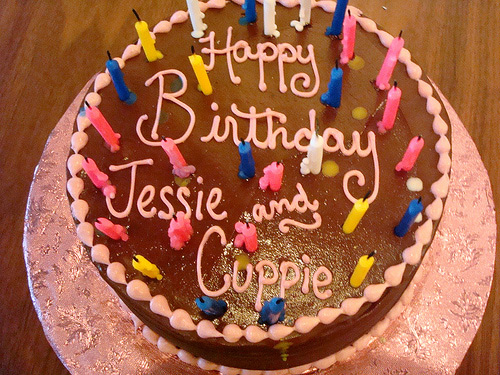 Of course, no matter how much you want to wonder about the origins of this delicious treat, one thing is for sure: no matter how you slice it, it's a happy occasion to eat whatever kind of cake you want for your birthday. In fact, why not have a second slice?
Of course, no matter how much you want to wonder about the origins of this delicious treat, one thing is for sure: no matter how you slice it, it's a happy occasion to eat whatever kind of cake you want for your birthday. In fact, why not have a second slice?

